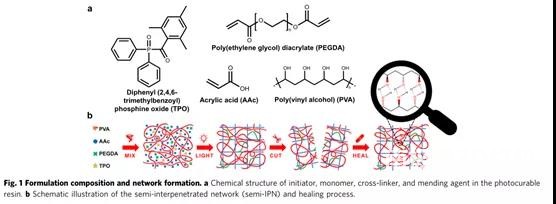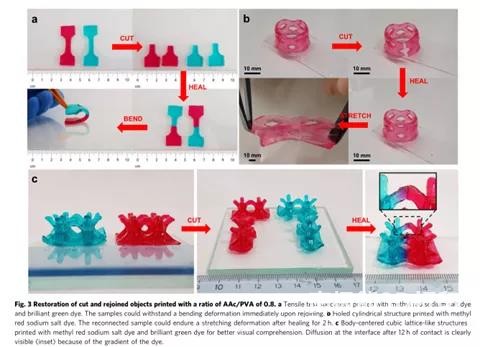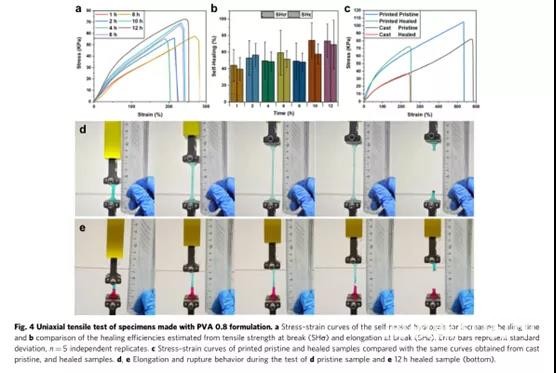Self-healing hydrogels can imitate the behavior of living tissues and can autonomously repair tiny damages.
biology
There is a high potential for medical applications. So far, this kind of hydrogel can only be processed by extrusion additive manufacturing technology, which has many limitations in terms of structural design and printing accuracy. Here, the research group of Ignazio Roppolo of Politecnico di Torino in Italy proposed to use a commercial DLP printer to light-curing and print a hydrogel with self-healing ability. These hydrogels are based on semi-interpenetrating polymer networks that can self-repair printed objects. Auto-recovery happens quickly at room temperature and does not require any external triggers. After the specimen re-healed, it was able to withstand the deformation and recovered 72% of the initial strength after 12 hours.The method proposed in this paper enables self-healing hydrogel objects with complex structures to3D printingBecomes possible for the transition from soft robots to
energy
Future applications in various fields such as storage have paved the way.
The research results are titled “3D-printed self-healing hydrogels via Digital Light Processing” and published in “Nature Communications”.
Article link:
https://doi.org/10.1038/s41467-021-22802-z
01
By adding the precursor of the chemical covalent network to the solution containing the linear polymer, a semi-interpenetrating hydrogel network is obtained. Combine non-photocrosslinkable polyvinyl alcohol (PVA) aqueous solution with acrylic acid (AAc), crosslinking agent poly(ethylene glycol) diacrylate (PEGDA) and diphenyl (2,4,6-trimethylbenzyl) Acyl) phosphine oxide (TPO) water-compatible photoinitiator was mixed to obtain a photocurable ink (Figure 1.a). Add organic water-soluble dye lemon yellow to improve printing resolution. PVA has inter-chain diffusion characteristics and the presence of hydroxyl groups that form hydrogen bonds, which makes PVA an attractive self-healing material. In preliminary experiments, the optimal molecular weight (MW) of PVA was determined to be 89-98 kd for our application. Low-molecular-weight PVA does not show sufficient self-healing properties, and high-molecular-weight PVSA provides suitable viscosity for DLP. Similarly, higher molecular weight PVA is also unacceptable, because the viscosity of PVA is also very high at low concentrations. AAc and PEGDA have been widely used in light-curable printing to make high-resolution objects because they can perform rapid light-induced free radical photopolymerization in large amounts of water. In addition, the carboxyl group of acrylic acid can form multiple hydrogen bonds with the PVA chain, thus contributing to the self-repair ability. In addition, large amounts of water hinder the use of many commercial photoinitiators because most photoinitiators used in photocurable printing have low water solubility. Therefore, the application of water-compatible photo-initiated nanoparticles developed in this paper is essential for realizing rapid printing in commercial printers.
Figure 1b depicts the formation of semi-interpenetrating: the physical network is mixed with the precursor of the chemical network, the latter being formed under light. The PVA chains are evenly distributed in the acrylic matrix. This semi-interpenetrating network allows the hydrogel to recover from loss: the sections can be reconnected through reversible physical crosslinks. In addition, self-healing occurs without external stimuli or adhesives, but only due to internal hydrogen bonds. This is because the printing material itself is already rich in functional groups that can form hydrogen bonds. In addition, the hydrogel contains a large amount of water, which provides fluidity for PVA to migrate through the fractured interface.

02
This paper also studied the photopolymerization kinetics of the ink (Figure 2a). The crosslinking time of the hydrogel is less than 10 seconds, which is within the acceptable range for high-resolution DLP printing, which indicates that the presence of PVA does not reduce the reactivity of the acrylate. Secondly, under different PVA concentrations, the difference between the initial storage modulus value and the different final plateau value can be observed. Finally, it was found that the concentration of the photoinitiator has negligible influence on the reaction kinetics (Figure 2b). Since the self-healing performance is expected to increase with the increase of PVA content, the results related to the 3D printable ink with the highest PVA concentration are mainly introduced here, that is, the PVA:AAc weight ratio is 0.8. In the ink components, only one cross-linking agent PEGDA is used, and its molar ratio to acrylic acid is 1:1000. This is the lowest concentration of crosslinker that makes printing successful. Increasing the concentration of PEGDA will result in a higher crosslink density, which can still print 3D objects, but has a negative impact on self-healing properties.
It should also be pointed out that the main challenge of DLP high-precision printing is to avoid the evaporation of water during the exothermic polymerization reaction. This leads to thickening of the printable ink, which leads to a gradual increase in the PVA concentration at the interface, and interferes with the layer separation/stacking step, resulting in a decrease in printing accuracy. We set up a humidifier above the trough to overcome this difficulty.

03
All self-healing tests are carried out in inks with a formula of 0.8 weight ratio of PVA to AAc.Combine several different shapes3D printingThe object is cut into two parts, and then the two parts are quickly placed together to qualitatively demonstrate the self-healing properties. In order to better visualize the self-healing, this paper cuts and reassembles the printed samples of two different colors, red and green (Figure 3). As shown in the figure, these structures have indeed been repaired at the macro level. Adhesion occurs immediately after re-bonding, and the repaired hydrogel can immediately maintain its own weight and bear bending deformation without breaking (Figure 3a). After 2h, the healed sample can withstand moderate tensile deformation before failure (Figure 3b). This self-repair can be attributed to the effective adhesion of the cross-section, which is due to the formation of hydrogen bonds between the carboxyl and hydroxyl groups on the interface.Complex with overhanging characteristics
architecture
The repair was successful (Figure 3c).

04
Tensile tests were carried out at different SH times, and quantitative time evaluation of the SH process was carried out (Figure 4a). As you can see, the system has recovered a lot in the first two hours. After that, the amount of recovery increased slightly with time, reaching an achievable recovery level after 12 hours of exposure (Figure 4b). As time increases, it may be the result of PVA inter-diffusion. The possibility of diffusion beyond the interface plane was qualitatively evaluated using two water-soluble dyes on different sides. After recombination, purple is observed at the interface. (Figure 3c), this is the result of mixing red and green dyes. Note that these two dyes have different diffusivities in the hydrogel, so purple seems to only appear on one side of the interface. The variability of the stress-strain curve shown in Figure 4b may be attributed to the irregular rupture of the healing specimen, which failed to extend at the interface as expected (Figure 4d). The original sample suddenly separated after reaching the ultimate tensile strength. The healed specimen did not split immediately, but gradually fell off along the cut area. This feature provides an additional safety mechanism for repairing samples, because it avoids the sudden detachment of the repair interface that is not too strong.

In short, a hydrogel with self-healing properties was printed by DLP. This method allows the manufacture of objects with complex structures. It solves the inherent incompatibility between light curing printing and self-healing properties, that is, the contradiction between high crosslink density and large chain mobility. The printing ink uses a water-based light-curing formula that produces a physical-chemical semi-permeable network. The covalent network of acrylic acid and polyethylene glycol diacrylate is combined with the physical network of polyvinyl alcohol. In addition, this article uses a commercial DLP printer to make the hydrogel structure. Due to viscosity limitations, self-healing can only be carried out at the highest printable density of PVA, which shows that there must be a trade-off between printability and self-healing. If the PVA content in the hydrogel is insufficient, it cannot support its own weight after cutting and contact, so the object cannot withstand the tensile test. In addition, if the PVA content is too low, the chain will be surrounded by excess water molecules, weakening the adhesion between the two parts in contact. The structure printed with the ink formula with the highest printable density of PVA can quickly self-heal at room temperature without external stimulation. After connecting the two incisions, they were immediately able to withstand bending deformation. After 12 hours of healing, the sample recovered 72% of the initial tensile strength. The presence of PVA introduces an additional safety mechanism for repairing samples, because sudden rupture can be avoided.In general, in this study, the authors have manufactured a self-healing hydrogel with a three-dimensional structure, which can be obtained through low-cost commercial3D printerAnd commercially available materials. The rigorous reaction conditions of self-healing materials and the complexity of the complex synthesis and purification procedures hinder large-scale production and economic practicability. Coupled with difficulties in forming, their potential applications are limited. Using a widely used instrument to process commercially available materials to manufacture 3D printed hydrogels will be able to quickly adapt to the proposed method and open the way for new applications in various fields, from biological and implantable sensors to soft Robots and energy storage.
(Editor in charge: admin)


0 Comments for “Nature Communications: 3D printing self-healing hydrogel with digital light curing technology”